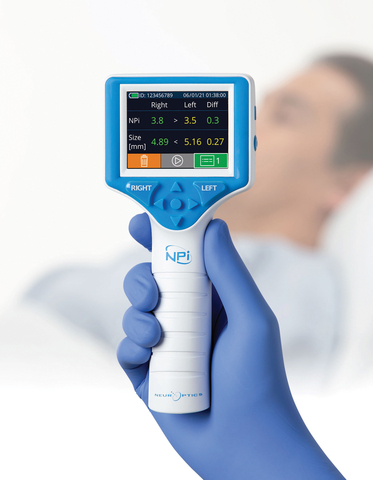IRVINE, Calif.--(BUSINESS WIRE)--NeurOptics’ Neurological Pupil index™ (NPi®) and automated pupillometry are now included in the updated 2021 European Resuscitation Council (ERC) and European Society of Intensive Care Medicine (ESICM) Guidelines for post-resuscitation care as an objective measurement supporting neurological prognosis in patients following cardiac arrest.
The ERC and ESICM guidelines outline the latest European post-resuscitation care science and treatment recommendations, based on the 2020 International Consensus on CPR and ECC Science with Treatment Recommendations (CoSTR), and are considered the gold standard of clinical recommendations in the practice of resuscitation science in Europe. The guidelines were last updated in 2015 and reflect alignment with the International Liaison Committee on Resuscitation (ILCOR) and associated member councils.
NeurOptics’ NPi Pupillometry has emerged as an important technology that provides a quantitative measurement of pupil size and reactivity, expressed as the Neurological Pupil index (NPi). The NPi measurement is an objective assessment of the entire pupillary light reflex (PLR) that previous studies have demonstrated can be an early indicator of neurological injury in critically ill patients.1-3 NPi values range from 0 to 4.9, with scores under 3 considered abnormal, and are not significantly influenced by common ICU medications such as opioids, neuromuscular blocking agents (NMBA’s), and sedatives.4
The latest ERC-ESICM guidelines cite several recent clinical publications investigating the value of NPi in post-cardiac arrest patient management, noting the evidence demonstrated “…unlike s-PLR, NPi can predict unfavourable outcome with no false positives from 24 h or less to 72 h from ROSC. In one study this was because of the ability of the pupillometer to detect a response even when the pupil size was very small, presumably from sedation…” Automated assessment of pupillary reactivity, measured by the NPi, provides an objective measurement of pupil size and reactivity to help support the prognosis of poor neurological outcome in patients who remain comatose 72 hours after cardiac arrest.3,5
“The inclusion of automated pupillometry and the Neurological Pupil index (NPi) in the European guidelines reflects the growing body of evidence indicating quantitative NPi has a superior ability to predict unfavorable outcome after cardiac arrest compared to standard manual pupillary examination,” said Fabio Taccone, MD, PhD, Director of the Neuro-ICU at Erasme Hospital in Brussels, Belgium and co-author of the 2021 ERC and ESICM Guidelines for Post-Resuscitation Care. “The objectivity and reproducibility provided by NPi pupillometry, especially for patients in the ICU on a variety of medications, makes it the gold standard for pupillary assessment in outcome prediction of our critically ill patients.”
The NeurOptics NPi Pupillometer eliminates the variability and subjectivity inherent in manual pupillary evaluation, providing a more accurate and reliable pupil size and reactivity measurement for patients with the potential for brain injury across a broad spectrum of conditions, including patients who have suffered cardiac arrest.
The 2021 European Resuscitation Council and European Society of Intensive Care Medicine Guidelines for Post-Resuscitation Care were co-published in Resuscitation and Intensive Care Medicine and can be found here.
About NeurOptics
Headquartered in Irvine, Calif., NeurOptics is the leader in the science of pupillometry. Driven by a passion to help clinicians improve patient outcomes, NeurOptics develops and markets innovative technology for use in critical care medicine, neurology, neurosurgery, emergency medicine, and research. The NeurOptics’ NPi Pupillometer has been included in more than 100 clinical studies, adopted in over 600 hospitals in the U.S., and is represented in more than 30 countries worldwide. For more information, visit www.NeurOptics.com. Follow NeurOptics on Facebook, LinkedIn, Instagram, and Twitter.
References
- Aoun SG, et al.: Detection of delayed cerebral ischemia using objective pupillometry in patients with aneurysmal subarachnoid hemorrhage. Journal of neurosurgery, 1: 1-6, 2019.
- Miroz JP, et al.: Neurological Pupil index for Early Prognostication After Venoarterial Extracorporeal Membrane Oxygenation. Chest Journal, February, 2020.
- Oddo M, et al.: Quantitative versus standard pupillary light reflex for early prognostication in comatose cardiac arrest patients: An international prospective multicenter double-blinded study. Intensive Care Medicine, 44(12): 2102-2111, 2018. DOI: 10.1007/s00134-018-5448-6
- Jolkovsky EL, et al.: Impact of acute intoxication on quantitative pupillometry assessment in the emergency department. JACEP Open, September, 2022. DOI: 10.1002/emp2.12825
- Soar J, et al.: Adult advanced life support: 2020 international consensus on cardiopulmonary resuscitation and emergency cardiovascular care science with treatment recommendations. Resuscitation 2020;156:A80A119, DOI: http://dx.doi.org/10.1016/j.resuscitation.2020.09.012




